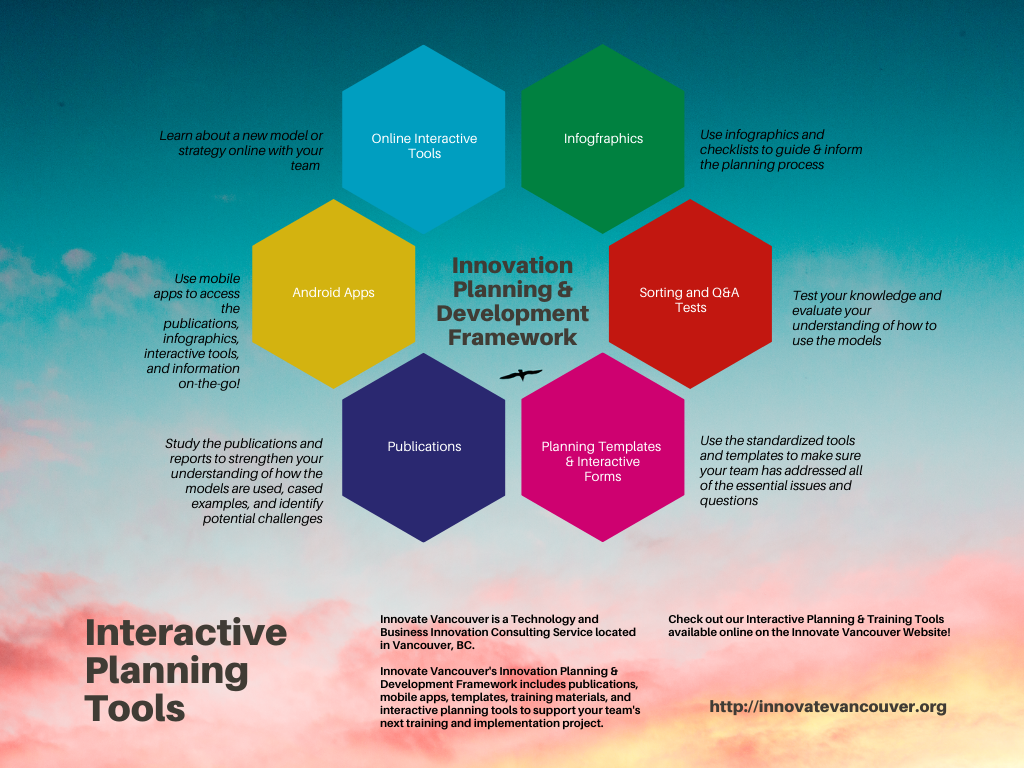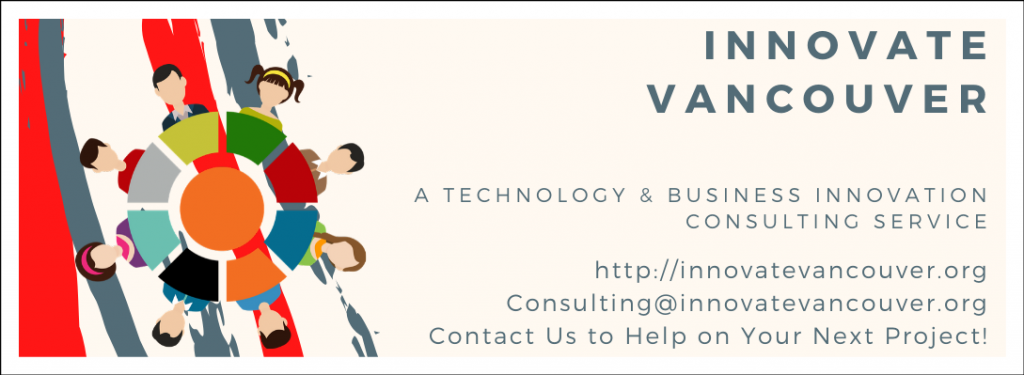The Strategic Innovation Plan Generator is part of the Innovate Vancouver Strategic Innovation Plan Learning Management System.
It supports virtual team joint learning, collaboration, and strategic planning efforts. This is achieved without needing to hire a consultant.
The Strategic Innovation Plan Generator is part of the Innovate Vancouver Strategic Innovation Plan Learning Management System. It supports virtual team joint learning, collaboration, and strategic planning efforts. This is achieved without needing to hire a consultant.
CREATE A BUSINESS CULTURE THAT SUPPORTS INNOVATION

The key to a sustainable competitive advantage is ensuring that your business’ product and service offerings remain relevant. They must solve a legitimate customer need. The infographic below represents the different components of the business model ecosystem.
Stronger components represent industry standards and best practices. They also lead the way to define and establish new standards and practices. Weaker components lag behind industry standards and best practices. They may not even realize the gap exists.
The Strategic Innovation Plan Generator includes the five stages below. The process starts with a review of the process map for using the Strategic Innovation Plan generator.
Next, there are phases that help evaluate your business model in specific areas.
You will identify tools and frameworks to introduce improvements where needed. Finally, you have an opportunity to draft and download your plan for the designated business areas.
All of these Business Ecosystem components need to be incorporated into your business model. Then, they can be ranked based on their strengths and weaknesses. (For an overview of this tool see the explainer video at the top of this page)
Mechanisms supporting innovation is not isolated to funding. It also involves public policy, legislation, regulatory frameworks, resources, training, values, culture, and other reinforcing mechanisms. Insisting on one vs. another mechanism without understanding the history of innovation is risky. It lacks awareness of values and the marketplace. This approach is similar to proposing a ‘one-size-fits-all’ model for innovation. This approach does not seek to understand how innovation can be accomplished. Evaluating the business model thus depends on industry changes, risks, and a number of other overlapping factors.
OVERVIEW OF THE STRATEGIC PLAN GENERATOR
The Strategic Innovation Plan & Learning Management Framework is an ideation and collaboration system. It is based on a network of proprietary publications, an Android app, and interactive web-based tools. This technology supports team collaboration across virtual and physical environments.
The Strategic Innovation Plan Generator includes the above steps (and strategic planning components) listed below. Additional tools, resources, and options are available to members.
EVALUATE YOUR BUSINESS
Step 1: Evaluate Your Business Model Components
Beginning with this specific business model area start to review what components are needed to be successful. Think of your business’ competitors in the area (local, national, or international).
How does your Business Model compare to competitors for customer satisfaction? How does it compare for employee retention? How does it compare for industry leadership, flexibility, and ability to support Innovation?
Step 2: Review and Decide What Business Model Tools to Explore
You need to choose the right tool to strengthen your business model. Consider the strengths and weaknesses of your business. You may find that some tools are more useful than others for strengthening your business model.
Begin by exploring the individual tools available to discover what you can do to strengthen your Business Model components.
Step 3: Strengthen and Build Your Key Business Model Areas
This is where collaboration, teamwork, and your leadership come in. Begin to fill out the interactive on page Business Model tool. Identify business strengths and areas for improvement in each business area. Print out & save a copy for your records.
Use these to facilitate leadership discussions when drafting your business plan & strategies (next step). Go back to other areas once your done.
Step 4: Plan – Leverage Your Business Model to Support Business Innovation
This is the final stage where you will apply what you learned in previous steps. Leverage your new Business Model components to support your strategic plan! Identify business strengths and areas for improvement in each business area.
Print out & save a copy for your records. Begin to fill out the interactive on page business planning tool. Go back to previous steps if you discovered other business model tools or areas that need improvement.
BUILD YOUR STRATEGIC PLAN
Executive Summary
The executive summary section provides a high level overview of the business environment. It builds upon the business overview section (mission, values, and business structure). It also describes the product/service offerings and customer categories. Additionally, it provides a high level review of the business’ goals detailed in the previous section.
Your team may choose to leave the summary (here) at the end of the planning document. Alternatively, you may attach it to the business overview section at the beginning of the plan.
Business Overview
The business overview section has a key purpose. It offers readers, coworkers, potential investors, or future business partners a glimpse into your company. It aims to provide coworkers and potential investors with a brief insight.
Future business partners also gain an understanding of your purposes. It also provides insight into its structure and mission. This information helps the reader of the strategic plan to better understand the context and industry of the following sections.
Sales & Marketing Plan
The sales and marketing plan establishes who your customers are. It outlines how they will be reached. It defines the value proposition of your product/service offerings. Without these channels, you have a limited understanding of the problem being solved by your company’s product/service. There is very little chance that your business will be able to thrive.
Human Resources Plan
Human resource assets drive value throughout the business model. Without effective human resource assets the performance in other areas would deteriorate and undermine the business. These areas include technical operations, financial, distribution & logistics, marketing & sales, services, and research & development.
Establishing a human resource plan supports the business’ recruitment efforts and training goals. It supports the strategic vision. It also provides opportunities for business model alignment, strengthening, and innovation.
Financial Plan
The financial plan establishes how financial and physical assets are allocated and used. The story that these numbers help provide highlights the mission, values, and direction of the business over the coming term. Although the numbers can seem intimidating to many, driving value across the business environment is simple. It involves understanding the story they tell.
Action Plan
The action plan incorporates the information from earlier sections. It establishes what goals are in place. It determines what strategies will be used to deliver these goals. It also supports performance evaluation. How goals are evaluated varies depending on the business and its priorities

